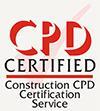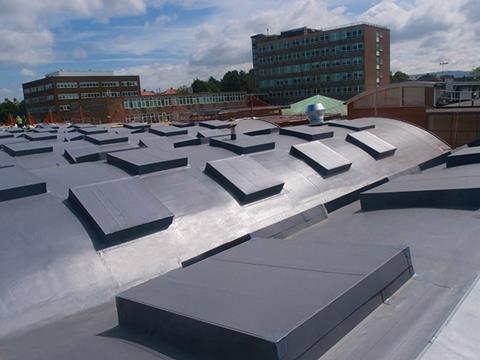The latest module in our CPD series outlines the recent changes to the CDM regulations, and explains how they will affect the way that project teams work. This module is sponsored by Sika Roofing

How to take this module
UBM’s CPD distance-learning programme is open to anyone seeking to develop their knowledge and skills. Each module also offers members of professional institutions an opportunity to earn between 30 and 90 minutes of credits towards their annual CPD requirement.
This article is accredited by the CPD Certification Service. To earn CPD credits, read the article and then click the link below to complete your details and answer the questions. You will receive your results instantly, and if all the questions are correctly answered, you will be able to download your CPD certificate straight away.
CPD CREDITS: 60 MINUTES
DEADLINE: 7 AUGUST 2015


INTRODUCTION
The Construction (Design and Management) Regulations were introduced by the Health and Safety Executive (HSE) in 2007 as a means of improving health and safety on UK construction sites, and reducing the risk of harm to those who have to build, use and maintain structures. They impose legal duties on virtually everybody involved in the construction process, including clients, designers and contractors, from the inception of a project to final demolition and removal. For the purposes of the CDM regulations, these people are often referred to as “duty holders”.
The 2007 CDM regulations actually applied to all sites, though this was not widely understood. There were additional duties for “notifiable” projects – that is, projects that took longer than 30 business days or 500 person days. These included the requirement for the client to appoint a “CDM coordinator” and “principal contractor”. The CDM coordinator had the legal responsibility to advise and assist the client on all of its health and safety duties and provide pre-construction information to the contractor. The principal contractor, meanwhile, had to develop a health and safety plan from this information and ensure that it was followed.
On 6 April 2015, a new version of the regulations (CDM 2015) was introduced. The update has been partly prompted by suggestions that there was still a lack of integration between health and safety requirements and design in the pre-construction phase of projects. It was argued that the CDM coordinator was often appointed too late to be embedded effectively in the pre-construction team.
The HSE also felt that instances of unacceptable standards were persisting, particularly on smaller sites. CDM 2015 will therefore bring a greater focus on smaller projects, as well as place new obligations on clients and facilities managers, through a number of significant changes. These include:
- Extending the scope of the regulations to include domestic clients
- Removing the role of the CDM coordinator
- Introducing a new duty holder: the principal designer
- Appointing a principal designer and principal contractor not only on “notifiable projects” but on all schemes where two or more contractors are on site (to “catch” smaller projects)
- Changing the project notification threshold.
It is in the interests of everybody involved in construction projects, but particularly those who procure them, to know and understand these obligations. This CPD will outline the major changes, and explain what they mean.

THE CLIENT’S ROLE
Under CDM 2007, the CDM coordinator was the client’s key safety adviser. The removal of this role therefore has a significant impact on project safety governance. If you are a client, you must make suitable arrangements for managing a project, including the allocation of time and other resources. Clients’ key responsibilities include:
- Notifying the HSE of the project details and confirming that the project team are aware of their duties
- Ensuring duty holders comply with their duties
- Providing the pre-construction information
- Ensuring that the minimum health and safety standards are maintained on site
- Ensuring that the construction phase health and safety plan is drawn up by the principal contractor
- Ensuring that a health and safety file is produced by the principal designer.
Perhaps the client’s most important duty is to appoint a principal designer and principal contractor, which are mandatory on projects with more than one contractor. In practice, these duty holders will carry out many of the functions listed above – although it is still the client’s duty to ensure that they are performing their roles. The client must make these two appointments “as soon as practicable”. In particular, the principal designer should be appointed as early as possible in the design process, ideally at concept stage. This will help the client to pull together the pre-construction information, such as asbestos surveys, existing health and safety files and structural drawings.
Failure to make these appointments will see their duties (outlined below) transfer automatically to the client.
The exceptions to this part of the regulations are domestic clients – which are defined in CDM 2015 as “clients for whom a construction project is carried out which is not done in connection with a business”. On domestic projects, most client duties are passed to other duty holders, and should the client fail to appoint a principal designer and contractor, these roles fall automatically to the designer in control of the pre-construction phase and the contractor in control of the construction phase of the project.
THE PRINCIPAL DESIGNER’S ROLE
The new role of principal designer takes on many of the duties of the CDM coordinator – although it is not a direct replacement. The principal designer must plan, manage, monitor and coordinate health and safety in the pre-construction phase of a project. This includes:
- identifying, eliminating or controlling foreseeable risks
- ensuring designers carry out their duties
- preparing and providing relevant information to other dutyholders
- providing relevant information to the principal contractor to help them plan, manage, monitor and coordinate health and safety in the construction phase.
The principal designer does not need to be the lead designer on the project, and it should never be assumed that the lead designer takes on this role by default – the appointment must be made in writing. CDM 2015 includes in its definition of designers: “architects, architectural technologists, consulting engineers, quantity surveyors, interior designers, temporary works engineers, chartered surveyors, technicians or anyone who specifies or alters a design”. It also states that the principal designer must be “an organisation or an individual with sufficient knowledge, experience and ability to carry out the role”.

THE PRINCIPAL CONTRACTOR’S ROLE
This remains largely unchanged from CDM 2007. The principal contractor must plan, manage, monitor and coordinate health and safety in the construction phase of a project. This includes:
- liaising with the client and principal designer
- preparing the construction phase plan
- organising cooperation between contractors and coordinating their work
- ensuring suitable site conditions are provided.
THE MANUFACTURER’S ROLE
On a roof refurbishment project where the manufacturer might directly be advising the client on design and specification, it is its duty to inform the client of its responsibilities under the regulations, and in other scenarios it will be its duty as a designer to comply with the requests of the principal designer.
NOTIFICATION THRESHOLD
Under CDM 2015, the HSE will need to be notified about projects exceeding 500 person days or “longer than 30 working days” with “more than 20 workers working simultaneously”. This should have the effect of reducing the number of notifiable projects.
The easiest way to notify any project to the HSE or other relevant enforcing authority is to use the online notification form F10 on the HSE’s website. Further information on how to notify construction work can be found at www.hse.gov.uk/construction/cdm/faq/notification.htm.
It is important to note that clients, designers and contractors still have responsibilities for those projects for which the HSE does not require notification.

TRANSITIONAL ARRANGEMENTS
The HSE recognises that there are construction projects that started before the CDM 2015 regulations came into force and continue beyond that date. For these projects (as long as there is more than contractor involved), the following transitional arrangements apply.
- Where the construction phase has not yet started and the client has not yet appointed a CDM coordinator, the client must appoint a principal designer as soon as practicable
- If the CDM coordinator has already been appointed, the client must appoint a principal designer to replace them by 6 October 2015, unless the project comes to an end before then
- In the period it takes to appoint the principal designer, the appointed CDM coordinator should comply with the duties contained in Schedule 4 of CDM 2015. These reflect the duties placed on CDM coordinators under CDM 2007 rather than requiring them to act as principal designers – a role for which they may not be equipped
- Pre-construction information, construction phase plans or health and safety files provided under CDM 2007 are recognised as meeting the equivalent requirements in CDM 2015
- Any project that was notified under CDM 2007 is still recognised as a notification under CDM 2015
- A principal contractor appointed under CDM 2007 will be considered to be a principal contractor under CDM 2015.

How to take this module
UBM’s CPD distance-learning programme is open to anyone seeking to develop their knowledge and skills. Each module also offers members of professional institutions an opportunity to earn between 30 and 90 minutes of credits towards their annual CPD requirement.
This article is accredited by the CPD Certification Service. To earn CPD credits, read the article and then click the link below to complete your details and answer the questions. You will receive your results instantly, and if all the questions are correctly answered, you will be able to download your CPD certificate straight away.
CPD CREDITS: 60 MINUTES
DEADLINE: 7 AUGUST 2015
Privacy policy
Information you supply to UBM Information Ltd may be used for publication and also to provide you with information about our products or services in the form of direct marketing by email, telephone, fax or post. Information may also be made available to third parties. UBM Information Ltd may send updates about Building CPD and other relevant UBM products and services. By providing your email address you consent to being contacted by email by UBM Information Ltd or other third parties. If at any time you no longer wish to receive anything from UBM Information Ltd or to have your data made available to third parties, contact the Data Protection Coordinator, UBM Information Ltd, FREEPOST LON 15637, Tonbridge, TN9 1BR, Freephone 0800 279 0357 or email ubmidpa@ubm.com. View our full privacy policy at www.building.co.uk/cpd




























No comments yet